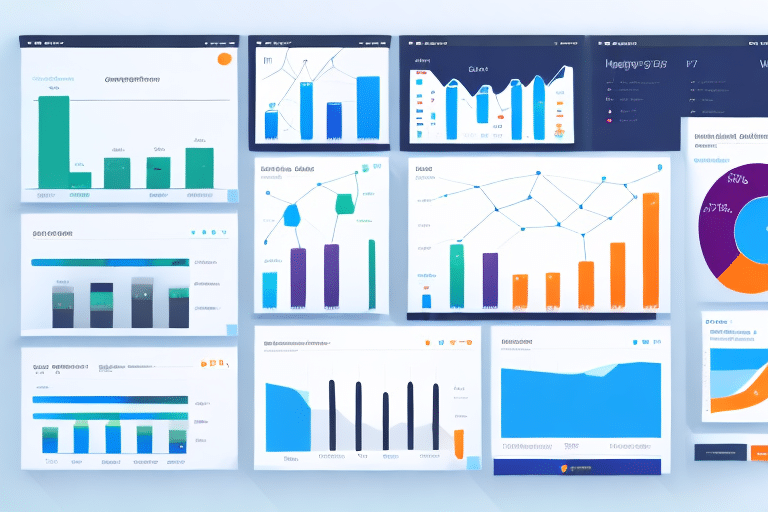Measuring Average Time on Site for E-Commerce Operations: Why It Matters
In today's digital age, e-commerce has become a prominent aspect of business. As online shopping continues to grow in popularity, e-commerce businesses must pay attention to every detail of their website to effectively attract and retain customers. One crucial metric that can help companies understand their website's performance is average time on site. In this article, we will explore the importance of measuring average time on site for e-commerce operations.
Understanding Average Time on Site in E-Commerce
Average time on site refers to the amount of time visitors spend on a website. It is calculated by dividing the total time spent on the site by the total number of visitors. This metric provides e-commerce businesses with insights into how engaged visitors are with their website.
Measuring average time on site is critical for determining user engagement levels. By analyzing this metric, businesses can assess their website's effectiveness in delivering the expected user experience. A higher average time on site generally indicates that visitors find the content valuable and are more likely to convert into customers.
Furthermore, average time on site can help identify potential issues with website design or functionality. For example, if the average time on site is significantly lower than industry benchmarks, it may suggest that visitors are struggling to navigate the site or find the information they need. Addressing these issues can enhance the user experience and increase the likelihood of conversions.
Key Components of Average Time on Site
- Total Time Spent: The cumulative time all visitors spend on the website.
- Number of Visitors: The total number of unique visitors to the website.
- Calculation: Average Time on Site = Total Time Spent / Number of Visitors
The Importance of Measuring Average Time on Site
Measuring average time on site offers several benefits for e-commerce businesses:
- Assessing Website Design and Layout: A well-designed website that is easy to navigate can lead to longer visitor engagement and higher conversion rates.
- Evaluating Content Quality: If users spend more time on the site, it indicates that the content is engaging and valuable.
- Identifying Performance Issues: Short average times may point to slow load times, broken links, or other technical issues that need addressing.
- Understanding User Behavior: Analyzing which pages retain visitors longer can inform marketing strategies and content placement.
According to a study by Sonicbids, websites with higher average times on site tend to have better user engagement and conversion rates.
Calculating Average Time on Site for Your E-Commerce Website
Calculating average time on site involves a straightforward formula:
Average Time on Site = Total Time Spent on Website / Total Number of Visitors
To measure this metric accurately, utilize web analytics tools such as Google Analytics. These tools track user interactions and provide detailed reports on various metrics, including average time on site.
It's important to compare your website's average time on site to industry benchmarks to assess performance. For instance, the average time on site for e-commerce websites typically ranges between 2 to 3 minutes. However, this can vary based on the type of products, content quality, and target audience.
Steps to Calculate Average Time on Site
- Access your web analytics dashboard.
- Navigate to the Audience Overview section.
- Locate the "Average Session Duration" metric.
- Ensure data is filtered to exclude non-human traffic (bots).
- Compare the metric against industry standards and historical data.
Factors Affecting Average Time on Site
Several factors can influence the average time visitors spend on an e-commerce website:
- Page Load Times: Slow-loading pages can frustrate users, leading them to leave the site prematurely.
- Content Quality: Engaging and relevant content keeps users interested and encourages longer visits.
- Website Design: Intuitive navigation and appealing design enhance user experience, increasing time spent on the site.
- Checkout Process: A streamlined and easy checkout process reduces cart abandonment and keeps users engaged.
- Mobile Optimization: With the rise of mobile shopping, ensuring your site is mobile-friendly can significantly impact average time on site.
According to Google, a delay of just one second in page load time can reduce conversions by up to 7%, highlighting the importance of site performance.
Common Mistakes When Measuring Average Time on Site
To obtain accurate data, avoid these common pitfalls when measuring average time on site:
- Ignoring Bot Traffic: Failing to filter out non-human traffic can distort your metrics. Use analytics tools to exclude bots and spiders.
- Device Discrepancies: Average time on site can vary between desktop and mobile users. Analyze data separately for each device type to identify specific issues.
- Content Type Variance: Different types of content engage users differently. For example, product pages may naturally have longer average times compared to blog articles.
- Contextual Factors: Consider the context in which users access your site. Time constraints, such as during lunch breaks, can affect how long users stay on your site.
By addressing these issues, businesses can ensure that their data accurately reflects user engagement levels.
Leveraging Average Time on Site to Improve User Experience and Conversions
Average time on site is not just a metric but a valuable tool for enhancing user experience and boosting conversions:
- Identify High-Engagement Pages: Determine which pages keep users engaged longer and replicate their successful elements across your website.
- Optimize Low-Engagement Pages: Identify pages with low average times and investigate potential issues such as poor content quality, slow loading times, or confusing navigation.
- Enhance Content Strategy: Use insights from average time on site to inform your content strategy, focusing on topics and formats that resonate with your audience.
- Streamline Navigation: Ensure that users can easily find what they're looking for, reducing frustration and encouraging longer visits.
Implementing changes based on average time on site data can lead to a more user-friendly website, higher customer satisfaction, and increased sales.
Tools and Analytics for Measuring Average Time on Site
Several tools and analytics platforms can help accurately measure average time on site for e-commerce operations:
- Google Analytics: A comprehensive tool that provides detailed reports on user behavior, including average session duration.
- Matomo: An open-source analytics platform that offers privacy-focused insights into user engagement.
- Mixpanel: A product analytics tool that tracks user interactions and engagement metrics.
Integrating these tools with your e-commerce platform allows for continuous monitoring and analysis of user behavior, enabling data-driven decision-making.
Conclusion
The role of average time on site in building a successful e-commerce business cannot be underestimated. By measuring this metric, businesses gain valuable insights into their website's performance, user expectations, and areas needing improvement. Through consistent analysis and data-driven optimizations, e-commerce owners can enhance user experience, increase customer engagement, and ultimately drive more sales and revenue.




















